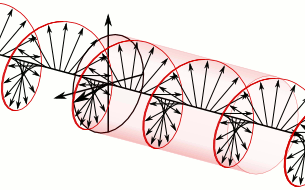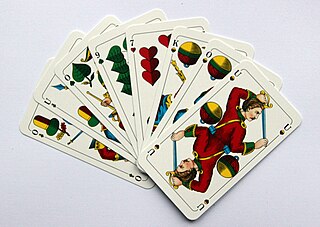Clockwise is a motion that proceeds in the same direction as a clock's hands. It may also refer to:
- Clockwise, a puzzle game for the Amiga CD32 games console
- Clockwise (band), a Swedish music project
- Clockwise (film) (1986), starring John Cleese
Clockwise is a motion that proceeds in the same direction as a clock's hands. It may also refer to:

The Northern Hemisphere is the half of Earth that is north of the Equator. For other planets in the Solar System, north is defined as being in the same celestial hemisphere relative to the invariable plane of the Solar System as Earth's North Pole.

In electrodynamics, circular polarization of an electromagnetic wave is a polarization state in which, at each point, the electromagnetic field of the wave has a constant magnitude and is rotating at a constant rate in a plane perpendicular to the direction of the wave.
CW may stand for:
Pitman shorthand is a system of shorthand for the English language developed by Englishman Sir Isaac Pitman (1813–1897), who first presented it in 1837. Like most systems of shorthand, it is a phonetic system; the symbols do not represent letters, but rather sounds, and words are, for the most part, written as they are spoken.

Edgware Road is a London Underground station on the Circle, District and Hammersmith & City lines, located on the corner of Chapel Street and Cabbell Street, within Travelcard zone 1. A separate station of the same name but served by the Bakerloo line is located about 150 metres away on the opposite side of Marylebone Road.
Orientation may refer to:
Reverse charge may refer to:

Numerical control is the automated control of machining tools by means of a computer. A CNC machine processes a piece of material to meet specifications by following coded programmed instructions and without a manual operator directly controlling the machining operation.

Seoul Subway Line 2, also known as the Circle Line, is a circular line of the Seoul Metropolitan Subway. The line running clockwise is called the "inner circle line" and the counter-clockwise line is called the "outer circle line". This is Seoul's most heavily used line, and consists of the main loop, the Seongsu Branch and the Sinjeong Branch for a total line length of 60.2 km (37.4 mi). The Line 2 loop is the second longest subway loop in the world after Beijing Subway Line 10. In 2019, Line 2 had an annual ridership of 812 million passengers or 2.2 million passengers per day.
Inner loop may refer to:

Parikrama or Pradakshina is clockwise circumambulation of sacred entities, and the path along which this is performed, as practiced in the Indic religions – Hinduism, Buddhism, Sikhism and Jainism. In Buddhism, it refers only to the path along which this is performed. Typically, in Indic-religions the parikrama is done after completion of traditional worship and after paying homage to the deity. Parikrama must be done with dhyāna.
Zydeco as a dance style has its roots in a form of folk dance that corresponds to the heavily syncopated zydeco music, originated in the beginning of the 20th century among the Francophone Creole peoples of Acadiana. It is a partner dance that has been primarily danced socially and sometimes in performances.

Tarneeb, also spelled tarnibe and tarnib, and called hakam in the Persian Gulf region, is a plain trick-taking card game played in various Middle Eastern countries, most notably in the countries of the Levant, and Tanzania. The game may be considered a variation of Whist, or a version of Spades.
Thpong District is a district (srok) located in Kampong Speu Province in central Cambodia.

The Spinning Dancer, also known as the Silhouette Illusion, is a kinetic, bistable, animated optical illusion originally distributed as a GIF animation showing a silhouette of a pirouetting female dancer. The illusion, created in 2003 by Japanese web designer Nobuyuki Kayahara, involves the apparent direction of motion of the figure. Some observers initially see the figure as spinning clockwise and some counterclockwise. Additionally, some may see the figure suddenly spin in the opposite direction.
Yolobus provides public transportation throughout Yolo County, California and into downtown Sacramento, western Sacramento County and northeastern Solano County.
A step sequence is a required element in all four disciplines of figure skating, men's single skating, women's single skating, pair skating, and ice dance. Step sequences have been defined as "steps and turns in a pattern on the ice". Skaters earn the most points in step sequences by performing steps and movements with "flair and personality", by turning in both directions, by using one foot and then the other, and by including up and down movements.
Bang was a Greek male vocal duo, consisting of Paul Stevens and Billy Adams (keyboards). They had chart success with the single "You're the One", released on the RCA label. It entered the UK Singles Chart on 6 May 1989, reaching #74. It was in the chart for two weeks. The B-side of the 7" version was "Don't Burn Down the Bridge", with the 12" having an additional instrumental version.

Two-dimensional rotation can occur in two possible directions. Clockwise motion proceeds in the same direction as a clock's hands: from the top to the right, then down and then to the left, and back up to the top. The opposite sense of rotation or revolution is anticlockwise (ACW) or counterclockwise (CCW).

Mucken or Muck is a variation of the popular German card game, Schafkopf. However, unlike Schafkopf, it must always be played in teams of 2 players, so there are no soloist or Rufer ("caller") contracts. Mucken is mainly found in the province of Upper Franconia in the German state of Bavaria. Mucken is often played in Franconian restaurants, as it is part of the Franconian pub culture. The details of the rules vary greatly, even from village to village.